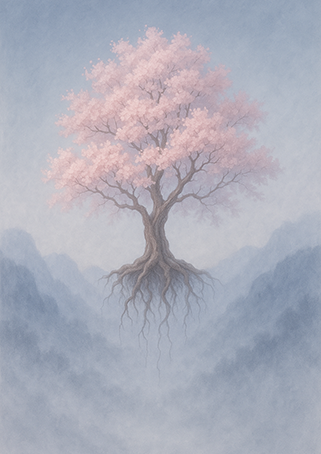Xieyi・The Rootless Tree:100 Verses-Verse 70#314

The poems of “The Rootless Tree” express a fundamental force rooted in harmony with heaven and earth, the cyclical flow of yin and yang, and the infinite potential of existence。
This painting is an expressive “Xieyi” in the tradition of “futu” (spiritual diagrams), passed down for generations in Wudang Mountain, China. It is drawn through a technique where energy flow (xingqi) channels the internal intention into visual form。 In the Taoist world, there exist spiritual and symbolic images called “futu”。
In the Taoist world, there exist spiritual and symbolic images called “futu”。
These are a type of talisman—not merely religious items, but expressive spiritual paintings that act directly on the mind of the viewer。
Since ancient times, many people have placed these Taoist-style “Xieyi” and futu in their homes, studies, or bedrooms, wishing for longevity, health, auspiciousness, and family harmony. Viewing such paintings was not just aesthetic appreciation, but an act of inviting the presence of the Dao into one’s life and tuning the body and mind。
Thus, “Xieyi” is more than artistic expression—it is a medium that bridges the spirit, life, and harmony with the universe。
This kind of artwork is not meant to be seen only with the eyes, but felt with the heart。
It communicates with the Dao, resonates with the qi of nature, and quietly stirs the viewer’s inner self。
Futu and “Xieyi” continue to live on from ancient times to this day as “sacred images that speak to the soul.”
Below, we present the original text of the philosophical poem “The Rootless Tree,” along with a modern Japanese translation and interpretation。
※ The author of “The Rootless Tree,” Zhang Sanfeng (1247–?), is also renowned as the founder of Tai Chi, and it is said that he applied the essence of this work to Tai Chi. As an additional note, we include an interpretation connecting this to the Tai Chi tradition of Wudang Mountain.
The Rootless Tree・Verse 70

▶Original Text
無根樹,花正開,陰陽歸一氣自來。太極自然無所執,真功顯現在人間。
▶Modern Translation
Now the rootless tree bursts into bloom;
Yin and yang return as one, qi arrives of itself.
Tai Chi is natural, free of grasping;
True skill reveals itself in daily life.
▶Interpretation
1.[無根樹,花正開] Blossom of ripened practice.
2.[陰陽歸一氣自來] Poles merge—spontaneous qi.
3.[太極自然無所執] Natural Tai Chi, cling to nothing.
4.[真功顯現在人間] Real power shines in human affairs.
▶Interpretation related to Tai Chi
• Time and cultivation make the art flower.
• When yin-yang fuse, energy emerges unforced.
• Beyond forms—movement springs from nature.
• Proof of mastery is found in ordinary actions, not demonstrations.
Copyright © MASAKI WAKABAYASHI. All rights reserved.




